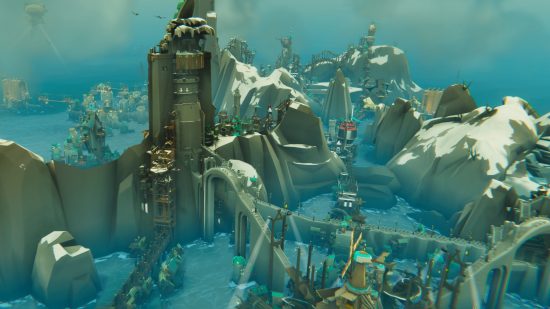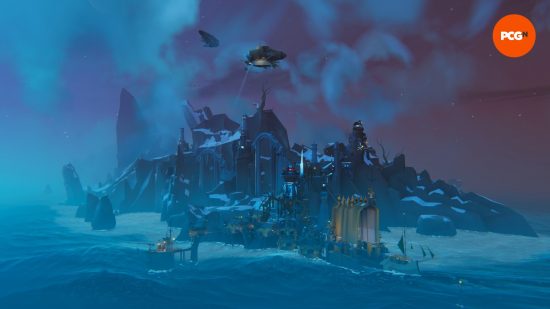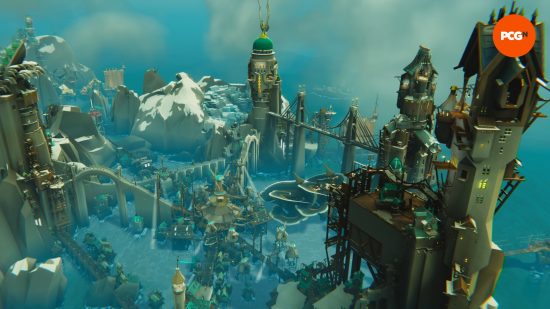Our Verdict
Simple and beautiful to look at, Bulwark: Falconeer Chronicles is a pleasant distraction but lacks the depth in its combat and economy to stay interesting for very long.
Any time I fire up a city builder, I’m always most excited about watching something organic play out. I love watching a community bloom from nothing, how it pops up from the bare earth and starts to sprawl outwards. Bulwark: Falconeer Chronicles is built on this idea, and while it lacks much mechanical depth and can feel clunky to play at times, it’s a relaxing and satisfying journey across the wind-swept Ursee.
If you’re looking for a city building game with Cities: Skylines or Frostpunk level of complexity, then Bulwark is probably not the game for you. This is a delightfully simple experience that takes more cues from Oskar Stålberg’s Townscaper than any of the children of SimCity. In Bulwark, you’ll drop outposts onto rocky promontories poking up out of the ocean waves, connect them with rickety gantries, and set out in your airship to look for resources that can be shipped back to the main settlement.
Bulwark is split in half, roughly between fiddling with settlements and watching them grow, and managing an expanding shipping network, which is periodically raided by pirates and rival factions. Neither of these activities is ever massively demanding, and so I’ve kicked back and relaxed while listening to a podcast or Sigur Rós track that matches Bulwark’s lonely, cloud-covered seas and stunning sunsets.
The building system is really the neatest bit. I’d start from an outpost and stretch outward with my cursor, looking for a potential place to build a new tower. These act as nodes in a settlement’s resource network, and they begin as flimsy structures made from wood. Every time I built a new tower, I’d also be building a catwalk that led from my starting point to the new structure. These could be straightforward sets of pathways and staircases, but they also might have to traverse drastic changes in altitude, and watching how my little workers decided to set up wild scaffolding to hold everything up in these cases was always a delight.

There’s not really any flat ground in Bulwark, and so citizens build their homes along these raised pathways and into the rocks around towers: little wooden shanties at first, barely hanging like barnacles onto whatever patch of support structure they have. As I gained access to more stone and iron resources I upgraded my towers and outposts, and the rickety wooden platforms could be replaced with graceful stone bridgework, carved stairways, and tunnels.
Bulwark includes three campaign scenarios, each of which can take a few hours to complete, plus a free build mode in which you can go to town creating the wildest cliffside castle city your CPU can handle. The free build mode in particular has lulled me into an almost meditative state, happily whiling the hours away while I upgrade my towers and watch as the new foundations and balconies emerge and alter their silhouettes.
It’s just a shame that there’s not much more to it than I’ve described. There are four factions in Bulwark’s campaign, and it’s theoretically important to keep an eye on which of these are getting the strongest in your settlement – it has an impact on how well you’re received when you find AI-controlled outposts, for example. There’s no penalty for tearing things down and trying something else though, so any factional issues can be solved in short order. I mentioned combat before, and there’s not much to add there either – I’d pilot my airship to wherever a battle was happening, and then just watch while everyone shot down enemy falconeers for a while, until finally I’d get a nice little victory screen.
My biggest complaint is that the control scheme can be extremely clunky and frustrating in the hand. The cursor moves relative to whatever object is currently selected, whether that’s the airship or a structure, and to move around the map, you have to select another point to build on or another existing object. Terrain can be extremely steep, and it can be difficult to tell what exactly I’m pointing at while trying to move around my islands, or to simply line up with an adjacent tower to upgrade the path to stone. I found this was an issue with both the controller and mouse and keyboard control schemes, although I generally found mouse and keyboard to be faster.
Apart from that, though, there’s not a lot here. The central mechanic of watching ramshackle platforms and soaring stone bridges appear between towers is lovely, but the combat and managing a trade network are quite shallow. It’s not a strategy game with hidden depths to discover beyond the first couple of hours.
Still, considering Bulwark is the work of a single developer, it’s an impressive achievement. Despite the ungainly control scheme and simple economics, I’ve enjoyed my time with it, whether I’ve been building gangplanks and towers around craggy volcanic formations or soaring serenely above the waves in my zeppelin, searching for whatever’s beyond the next cloudbank.



